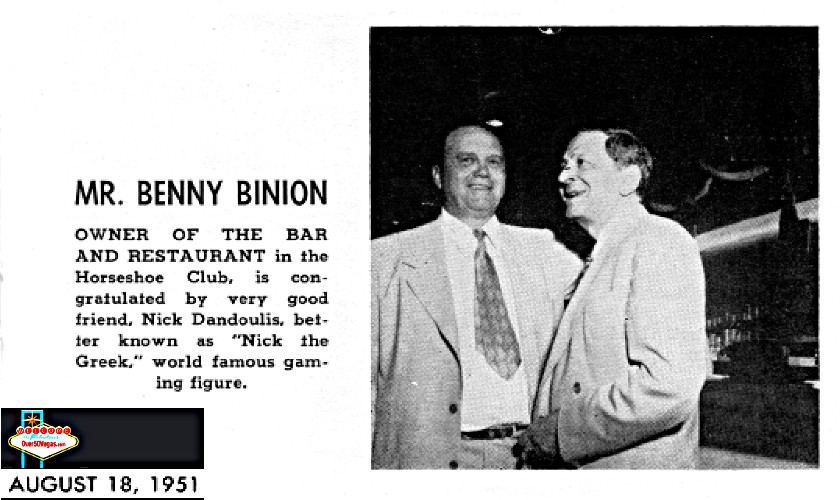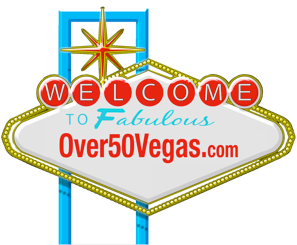- About Over50Vegas
- How did Las Vegas become Las Vegas?
- Observations by Charles "Pop" Squires- Las Vegas Pioneer and Publisher
- Books and References Sites
- Las Vegas Phonebook and City Directories of Bars, Casinos and Hospitality Properties
- Casino Collectible Shows & Local Meetings
- Visit the ChipGuide
- Visit the Museum of Gaming History
- Visit the Casino Chip & Gaming Token Collectors Club, Inc.
- Sitemap by name of property
- Sitemap by address of property
- Click here to request page update notifications
- Contact Over50Vegas
128 Fremont
Las Vegas, NV
Horseshoe
Club
1951 to 195
3 and 1958 to 1964
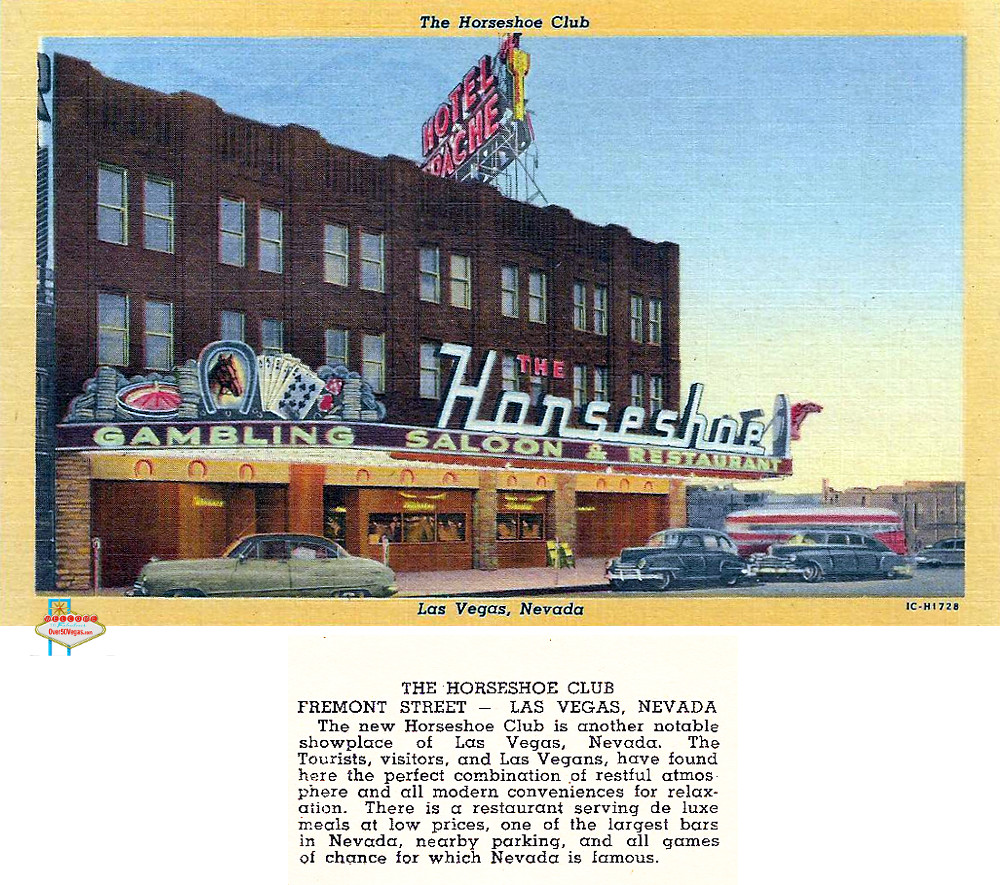
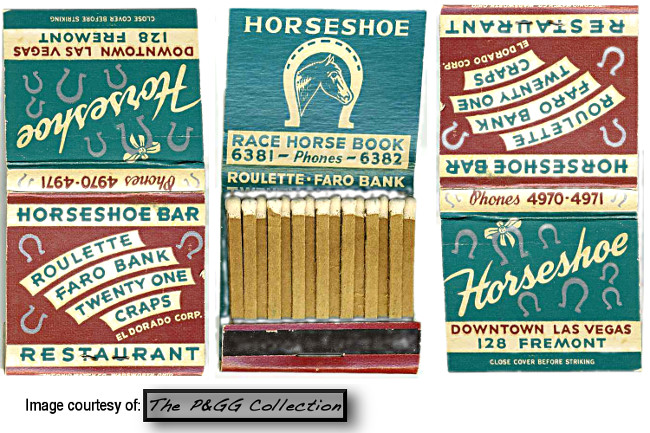
This is one of the first books of matches from the Horseshoe Club.
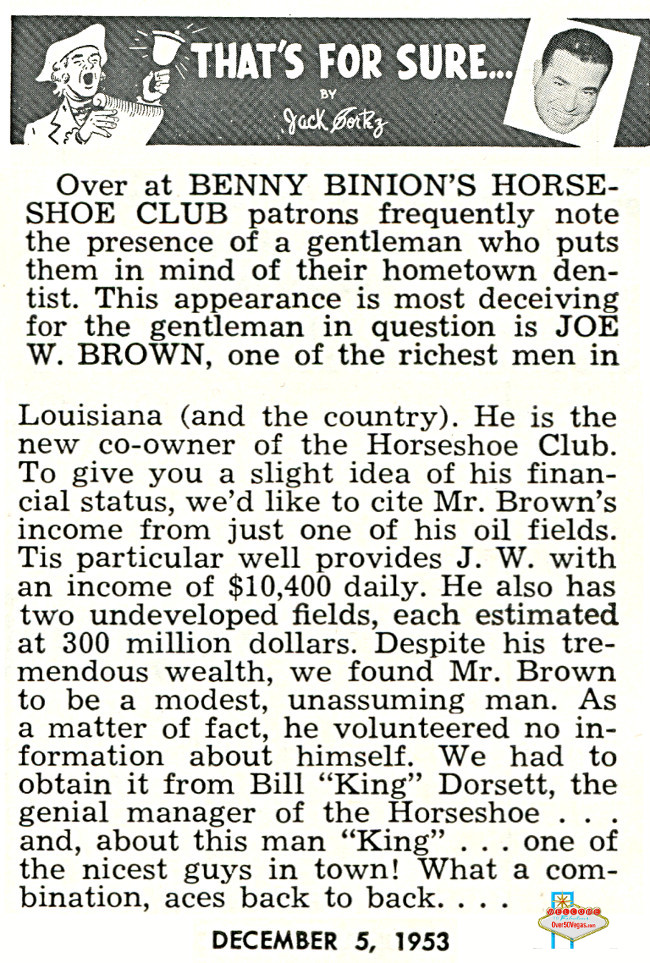

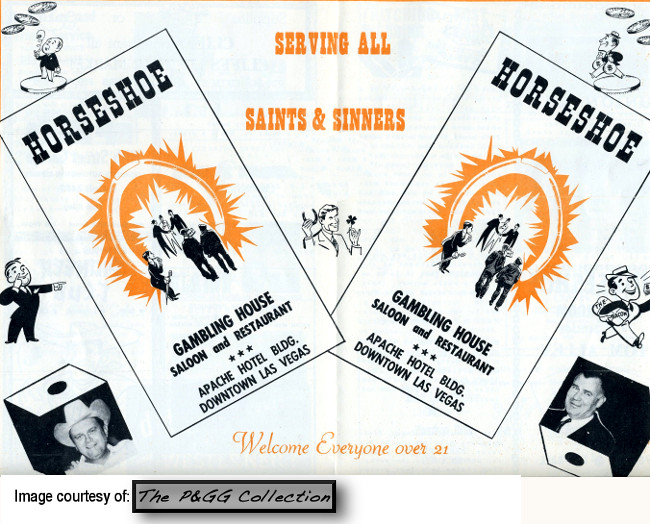
The birth of the Horseshoe Club
In May of 1951 Benny Binion bought 87 ½% of the Eldorado Club from Dr. Monte Bernstein. He had also bought the lease rights from P. O. Silvagni, the owner of the Apache, where the Eldorado was located. However, the transaction had not yet been approved by the state tax commission.
The Eldorado had been closed for several weeks previously due to a dispute between Monte Bernstein and P. O. Silvagni regarding the lease. Binion's attorney said that when the property reopened it would be under the name, “The Horseshoe Club.” The purchase price was reported to be $250,000. At the time Binion did not hold a state gambling license as he had sold out his interest at the Westerner and would have to apply for a new license to operate his Horseshoe Club.
A few weeks later Binion applied for a gaming license and was denied. On June 14, 1951, Binion's partner in the Horseshoe, Dr. Monte Bernstein applied for the gaming license without Binion's name on the application. The Nevada tax commission took no action on the application but were reported to be “cool to the proposal”.
Meanwhile on July 9, 1951 the Las Vegas City commissioners postponed a session for two weeks where Benny Binion and Dr. Monte Bernstein were to apply for their city gambling and liquor licenses. Bernstein had applied for the city gambling license and Binion had applied for the liquor license for the adjoining Apache Hotel. The applications were separate but under the umbrella of the Eldorado Club corporation. Bernstein was applying for the gambling license alone after the state tax commission had already turned Binion down for the state gambling license.
All during the weeks of the application process, even though getting a gambling permit was not assured, Binion continued to remodel the Eldorado into his new Horseshoe Club. He installed the first casino carpeting and set new policies to attract diehard gamblers including free drinks to the average gambler and treating everyone like a “high roller.” These policies were revolutionary at the time but because of Binion's vision have become commonplace today.
Although the City of Las Vegas commissioners were in favor of granting Binion a gambling license, the state tax commission refused to give him even a “probationary” license. They contended that giving him a license in light of his run-ins with the law in Texas would give the state of Nevada a “black eye”. However, the city commissioners did not want to give Monte Bernstein a gambling license as they thought he did not have enough experience running a club and had done a poor job running the Eldorado. But successful gambling experience was something that Binion had in spades!
On August 8, 1951 the city commissioners granted Dr. Monte Bernstein a city gambling license as the sole owner of the Horseshoe Club. Bernstein said that he had given Benny Binion a two year option to buy if he is ever granted a state gambling license. At the city commissioner's meeting, the city attorney, Howard Cannon, testified that Binion had invested $350,000 remodeling the old Eldorado into the new Horseshoe Club. He would be repaid by a series of notes through the Eldorado corporation. Binion had also purchased P. O. Silvagni's slot machine interests for $175,000 and had bought the bar from Matt Howard. Added to those outlays of cash, Bernstein and Binion had also paid off $87,500 in debts of the former Eldorado Casino operators. Bernstein's approval to open the Horseshoe was actually a renewal of his former license to operate the Eldorado.
The state gambling commission finally gave the gambling license for the Horseshoe Club to Dr. Monte Bernstein at the end of July, 1951 after Bernstein gave his word that, “Binion would not be connected to the club.”
Another interesting early Horseshoe story is about the chips used when the casino opened. Monte Bernstein had given his word to the state commission that, “Binion would not be connected to the club.” But just before the opening of the club, when the chips arrived from the manufacturer they were emblazoned with “Binion's” in gold stamp.
“Too late to get replacement chips, Bernstein grabbed several ladies who were working at the club and immediately put them to work scraping Binion’s name off the chips. They spent most of the night doing so. |
When the club opened the following morning these chips were on the tables |
It’s been said that the chips were scraped when Joe W. Brown took over the Horseshoe in December 1953 and that the “B” and the “n’s” remained on the chip because it could be viewed as saying “Brown’s”—the same could be said for “Bernstein’s”, but it’s uncertain whether Bernstein had this in mind. His main concern was making Binion’s name illegible. |
The scratched off chips are in denominations of $100, $25, $10, 2 different $5’s, a $1 and 3 different 25c. I am told a few $5 exist un-scratched." |
When the Horseshoe Club opened on August 14, 1951, Benny Binion was licensed only for the bars and restaurant. He was not the holder of the gambling license! But even though the Horseshoe Club was “technically” not Benny's, everyone knew who was running the show. Even in the pictures advertising the grand opening, Benny is described as “owner of the bar and restaurant in the Horseshoe Club.”
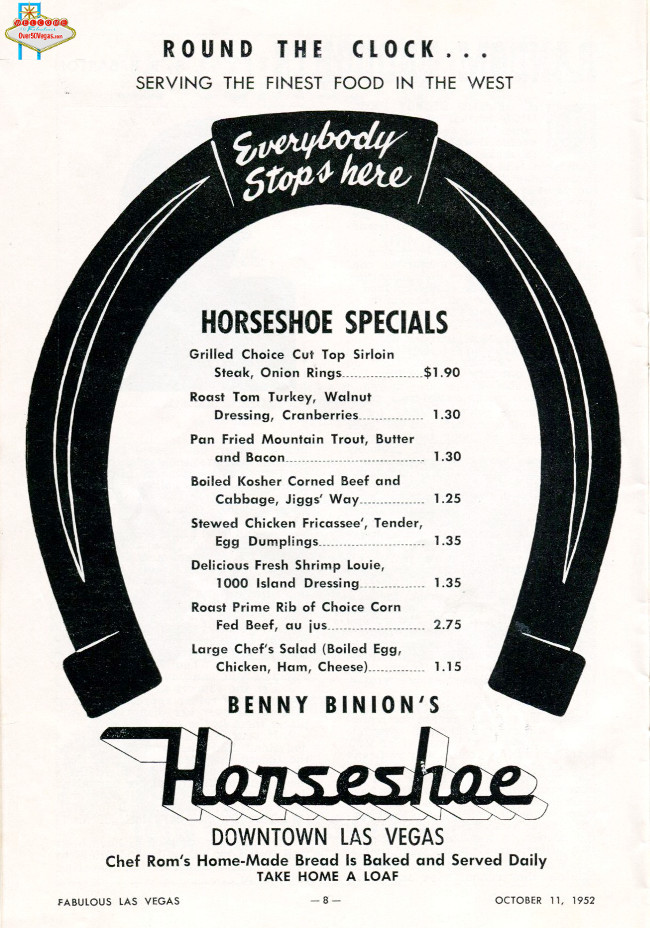
During October of 1951 local officials and city power players began to heavily lobby the state tax commission to grant Binion a license for what was essentially “Benny's Club”.
Even though he was not licensed and Dr. Bernstein had given his word that Benny would not be involved in running the club, it was an open secret that he did indeed run the business. It was implied that the state commission were being made fools of and it would just be simpler and more expedient to grant him the license.
In mid November of 1951 the state tax commission sent two investigators to Texas to look into Binion's background there. They had first done so in 1946 when he applied for a license with the Las Vegas Club in a partnership with J. K. Houssels Sr.. The commission claimed they simply wanted to bring his “file up to date, because there had been a lot of misinformation and misunderstanding” because they had granted him a license five years earlier and refused one now. The commission believed that Binion was planning to apply for a license again at the end of November. At this point Binion's proponents in lobbying the commission in his favor included bankers, attorneys, businessmen, city officials, and even women's club leaders. However, while the city leaders were pulling for Binion to be licensed, he was still under indictment in Texas on charges of operating a million dollar policy racket. The Nevada courts, however, refused to extradite him.
On December 1, 1951 at 11:25 am, four state highway patrol officers stood guard so Benny Binion would be assured of a private meeting with the state gaming commission.
Reporters were barred from the meeting but were told that the commissioners spent a full hour before Binion's arrival going over the reports of his activities in Texas that had been gathered by their investigators.
Binion left the meeting at about 12:15 pm and told reporters that he would have had no problem letting them attend the meeting. The reporters were allowed in for the rest of the meeting at which state senator E. L. Nores made an appeal on Binion's behalf to the the commission saying that “Binion is a man you can believe in... he is a man of high character.” He went on to say, “If you don't grant this license you are making a serious mistake.”
When it came time to vote, the commission, including Governor Charles Russell, voted unanimously to grant Binion a license. For a casino he had been allegedly running for months anyway! During the closed door session it was reported that both Bernstein and Binion testified under oath that Binion had not run any of the gambling at the Horseshoe.
The commission announced that part of their decision to grant Binion a “probationary” license was because they were not satisfied with how the Eldorado corporation was operating the casino. Binion's probationary license could be revoked at any time if his personal actions in the future “Brought discredit upon either himself or the state.”
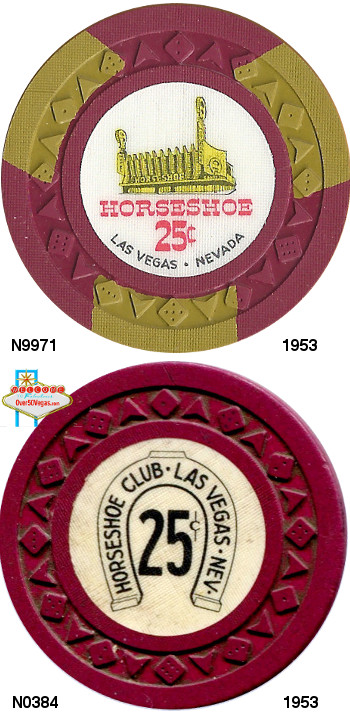
So as of December 1, 1951, The Horseshoe Club was indeed "Benny Binion's" club.
Which means that from August 14, 1951 to Nov 30, 1951 it was actually...
"Monte Bernstein's Horseshoe Club"

Binion had successfuly won his gambling license back and went about making the Horseshoe Club into one of the most successful of the early casinos. But his troubles with the legal system were not over...
In July of 1952 a Texas federal grand jury indicted L. B. (Benny) Binion on charges that he underpaid his and his wife's 1949 federal income taxes by some $14,000.
Binion had earlier fought extradition to Texas on state charges of operating a numbers racket in Dallas. His attorneys and the U S Attorneys had agreed to transfer the case to Nevada but Attorney General James P. McGranery intervened and ordered Binion returned to Dallas for the trial.
The Nevada gaming commission, on February 3, 1953, discussed the application of Robert F Caudill of Las Vegas for a 2 ½ % interest in the Horseshoe Club whose major interest is held by Benny Binion who would retain an 85% interest in the club while he was under orders to return to Texas on an income tax indictment. The point was made that Binion's license should be revoked if he is found guilty in Texas and should not be allowed to sell portions of his operation while under indictment. At the same meeting, Clarence E. Cannon and Kenneth Cannon had licenses granted for poker games at the Horseshoe Club.
On June 7, 1953, Benny Binion turned himself in to Dallas County Sheriff Bill Decker to face charges of operating a $1 million year policy racket in Texas. He had unsuccessfully fought extradition to Texas to face the federal charge of evading is 1948 income taxes.
In September 1953, Benny Binion pleaded guilty in San Antonio, TX to charges of evading income tax for the years 1945 through 1948. He was set free on bonds totaling $25,000.
A federal judge denied Binions request for reduction in the terms of parole imposed in the Nevada federal courts in 1952. He had pleaded no contest to charges of evading 1949 income taxes and he was placed on probation for five years. He requested that the probation be reduced to 14 months but the plea was denied the decision mailed to the court clerk in Carson, Nevada.
In a November 23, 1953 article regarding the various plans for the sale of the Horseshoe it said that Robert “Dolby Doc” Caudill owned a 2½% piece of the club. However in subsequent articles Caudill's name and interest in the club never came up.
On December 2, 1953, Benny Binion's sentencing for income tax evasion was postponed for a second time and he was now scheduled to be sentenced at 2 PM on December 14,1953 in San Antonio Texas. Binion was given 12 days to sell his casino interest before he would find out the total amount he would owe to the government. Binion claimed that as late as a week before he did not know what he would owe the government and he did not get final figures until he arrived in Texas for sentencing. The US Attorney said there was no legitimate reason to delay the sentencing. He said Joe W. Brown, New Orleans millionaire, was buying a 50% interest in Binion's Horseshoe Club but that Brown had not obtained Nevada gambling license.
You can read a little more about
Joe W. Brown in the article to the left.
On Dec 7, 1953, Benny Binion turned over a check for $516,541.93 to the Internal Revenue Service for unpaid taxes, penalties, and interest. The government released the liens which it had filed against about $1 million worth of his property in Nevada, Texas, Louisiana, Montana and Mississippi to secure payment on the back income taxes for the 1945 through 1948 period.
He still faced sentencing December 14, 1953 in Texas on criminal charges of 4 counts of income tax evasion to which he pleaded guilty. He also faced charges in Dallas for running a policy racket before his move to Las Vegas. Texas state authorities planned prosecute their case when the federal government completed its tax case.
Binion was still on probation at this time after pleading 'no contest' to another income tax evasion charge on his 1948 taxes which he had paid off in 1952. At that time he was fined $15,000 and sentenced to 5 years probation.

The reports of the day had various numbers given for the percentages that Joe W. Brown and others were buying of the Horseshoe.
In an article on December 10, 1953 , Joe W Brown, who was described as a wealthy New Orleans oilman and sportsman, put in an application before the state gaming commission for a 45% interest in the Horseshoe Club. Brown's nephew W. C. Dorsett, the general manager of the casino, was seeking approval for a 5% interest.
A report on the same day in another newspaper states that Joe W. Brown was seeking a much larger share of the club. The Nevada gaming commission was considering the application of three men who wanted to buy out Benny Binion's interest in the Horseshoe club. Joe W. Brown applied for 92½ % of the club. William Dorsett, also from New Orleans, 5%, and Robert F. Caudill of Las Vegas 2½ %.
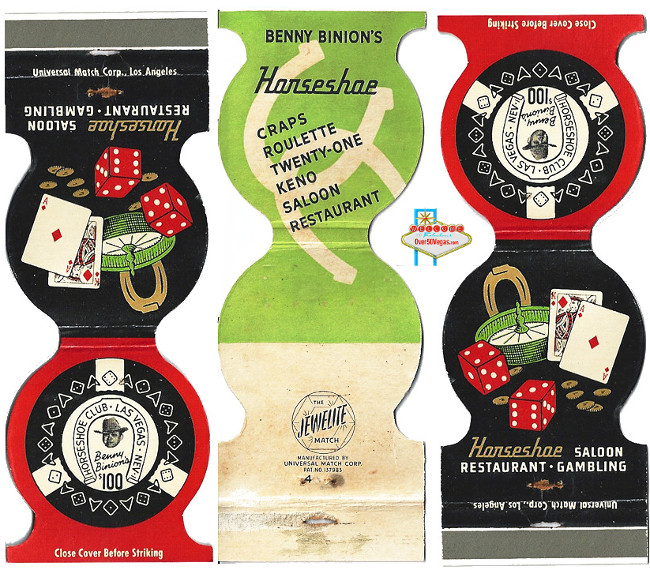
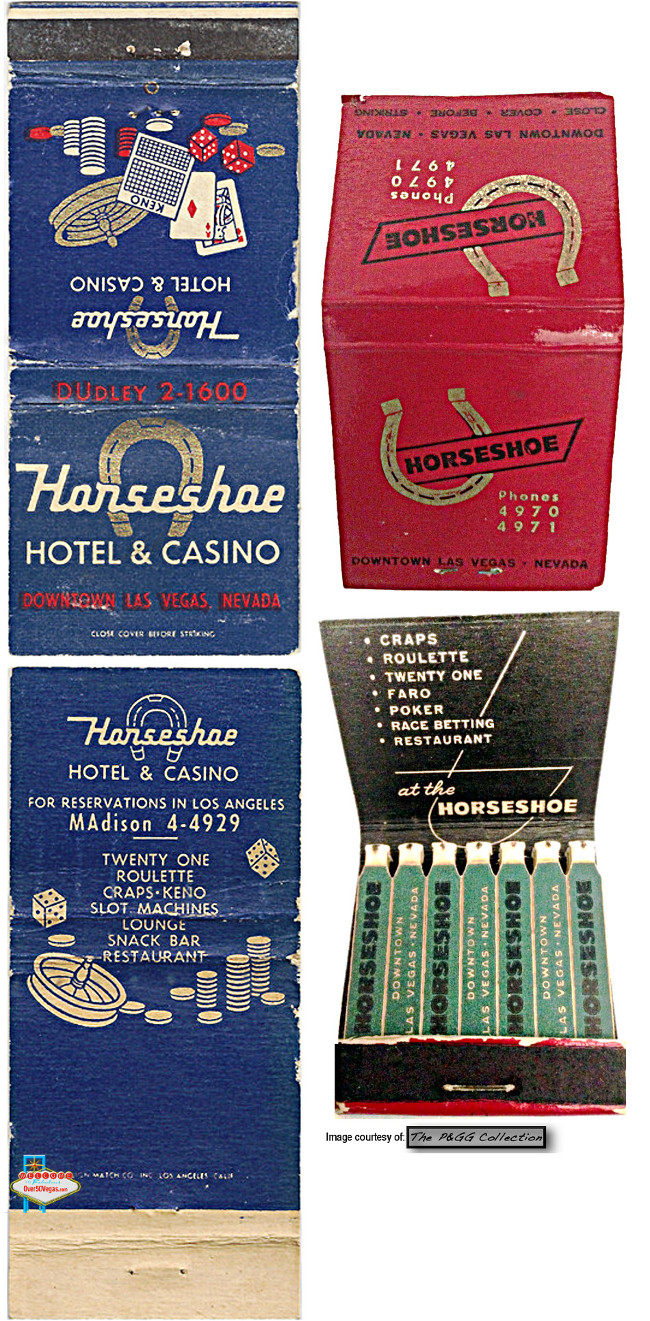
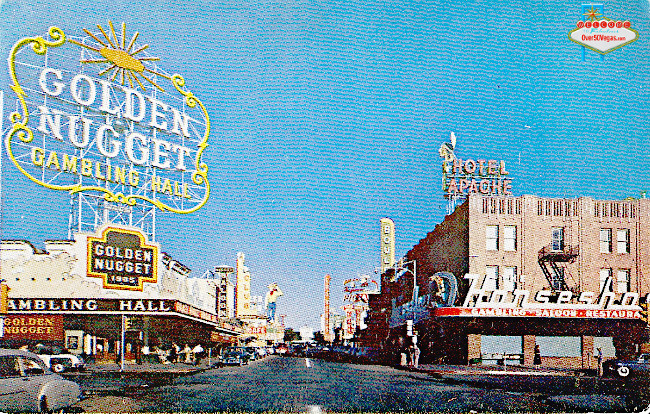
On December 11, 1953 the Nevada tax commission approved the sale of Binion's Horseshoe Club to Joe W. Brown who paid $858,000 for 97½% interest in the casino. Brown gave 5% interest to his wife's nephew, W. C. Dorsett, formerly of New Orleans, who had been the general manager of the Horseshoe for the previous several months.
Both Brown and Dorsett were granted Nevada state gambling licenses. These actions removed Binion from the Nevada gambling scene and was a precursor to his losing his Nevada gambling license.
In his appearance before the commission, Joe W. Brown said he bought the casino as a favor to Binion and to provide jobs for employees of two gambling clubs he operated in New Orleans. Brown had operated the Jai-a-Lai Club near New Orleans and also operated a horse-book and dice game in the same area from 1934 to 1947.
Under oath, Brown denied he had ever been associated with the notorious figure “dandy” Phil Kastel, although he was 'acquainted' with him. A commission investigator who had traveled to New Orleans could find no links between Brown and any crime syndicate and said he had enjoyed an “excellent reputation” among businessmen and officials in the area.
The commission disclosed that Brown's net worth was over $5 million dollars and he had an income of over $1 million a year stemming from 11 producing oil and 8 gas wells.
This article notes that Binion was first licensed in Nevada in 1948 after he left Texas to avoid prosecution in a $2 million dollar a year policy racket.
On December 14, 1953 Benny Binion was sentenced to five years in federal prison and fined $20,000 by federal judge Ben H. Rice on four counts of tax evasion. He was given 5 concurrent years in prison on three counts and three years probation on the fourth count. His probation would start after he served his prison time, provided all fines had been paid.
As Binion's wife and one of his daughters watched in the courtroom, Binion told the judge that he had not tried to cheat the government, saying, “I'm just kind of ignorant, gambling and all.”
Up to this point Binion had paid the government $638,000 of about $800,000 he owed in back taxes.
Dallas District Attorney Henry Wade said he was attempting to also try Binion in Texas state court on the charges stemming from his Dallas policy racket in the days before he moved to Las Vegas. Wade said if that was not possible then they would wait until he was released from federal prison to pursue the charges.
On December 15, 1953 Benny Binion accepted an offer from Dallas District Attorney Henry Wade for a four year state prison sentence stemming from his Dallas policy racket in the days before he moved to Las Vegas. The state sentence would run concurrently with his five year federal prison sentence for income tax evasion.
On December 18th, 1953, Benny Binion sat in a Dallas county jail as he awaited transfer to Leavenworth Federal Prison for a five year prison stint.
He was described as a “Dallas policy racket operator” who would actually be serving four concurrent sentences. Three, of five years each, for the federal government and a four year stretch for the state of Texas. If Binion was paroled by federal authorities before he served four years, he would finish the shorter sentence in the Texas State prison at Huntsville.
He received his lightest sentence on his plea of guilty to running a $1 million year policy racket in Dallas. The other sentences were assessed by a federal judge on his guilty plea to four counts of income tax station.
You can read a very interesting interview with Benny Binion conducted by UNLV by clicking here!
Binion was actually indicted in December 1949 but it took almost 4 years for Texas to get their hands on him on the gambling charge. He had left the state before he was indicted after a raid which led to a four-year sentence for his Dallas partner Harry Urban. He was twice ordered extradited from Nevada but both times he won permission from the courts to stay.
After Benny went to prison in the 1950's he never held a Nevada gaming license again. However, he was always employed at his namesake properties as a “consultant.
The article to the left mentions Joe W. Brown and Cecil Lynch as "operators" of the Horseshoe Club Bingo room. Brown was a friend of Benny Binion and at the time the article was written actually owned the Horseshoe Club. Cecil Lynch had interests in several downtown casinos would go on to own other casinos of his own.
On March 12, 1957 the U.S. Supreme Court ruled that Benny Binion, and New York Mobster Frank Costello should be admitted to bail pending appeals of their unrelated income tax evasion convictions. Binion had been sentenced in 1953 and had been serving time in Leavenworth federal prison.
By March 25, 1957, Binion had returned to his Las Vegas home for a reunion with his family after posting a $25,000 bail bond.
Upon his return home Binion said,
“My only immediate plans are to take care of my Montana ranch and visit my family I do plan a trip to Arizona next week to see about buying a string of cattle” |
His Friend Joe W. Brown still owned and was operating the Horseshoe.
Go to: Joe Brown's Horseshoe Club
Joe W. Brown sells the Horseshoe to the Fremont Corporation
The Fremont Corporation became the owners of the Horseshoe Club in September of 1958 and assumed the lease on the Apache Hotel. The actual transfer of the property from Joe W. Brown hinged on the gaming commissions approval of license changes.
On Sept. 25, 1958, the gaming control board granted operators of the Fremont Hotel and Casino permits for emergency participation in the operation of the Horseshoe Club. Then, on October 23, 1958, the commission approved licenses for 16 of the 17 men who were taking over the Horseshoe club from Joe W. Brown for $1,120,00.
Ten of the men were already licensed for the Fremont Hotel which was across the street from the Horseshoe in downtown Las Vegas. This group was headed by Ed Levinson who invested $193,000 in the Horseshoe.
The others who were approved for small interests were: Fred and Robert E Ayoub, Fritz F. Gersich, Lawrence M. Knight all of Las Vegas and Harry E Wrest of St. Louis. None of the latter men held any interests in the Fremont.
Leo D. Durr's application for 5% of the Horseshoe was on hold because the investigation into his background was not yet complete.
I have broken out the Horseshoe Clubs by owners/operators/era.
You can click on the links below to go to those pages.
1951 to 195
3 and 1958 to 1964
195
3
to 19
58
19
64
to 200
5
2005 to present
A note about the dates above. You can
find a wide variety of dates that either agree
or contradict these dates. I used dates from
the best records I could find and from
newspaper and gaming commision reports
of the time. In other words, everyone has
their own opinion! Enjoy!

Over50Vegas.com by Over50Vegas.com is licensed under a Creative Commons Attribution-NonCommercial-NoDerivs 3.0 Unported License.
Based on a work at http://over50vegas.com/index.html.
This is a non-commercial, educational, hobby site. Images on this site are from our personal collection and from personal collections of fellow enthusiasts who have shared their scans with us. Other images are noted by source with links to the original. If you feel that any image used here has infringed upon fair use of an image you hold the copyright to, please contact us at the links above and it will be credited or removed at your request.
Sources you might want to visit for more information include:

Search for anything on this site. Click "Advanced" to narrow your search.
